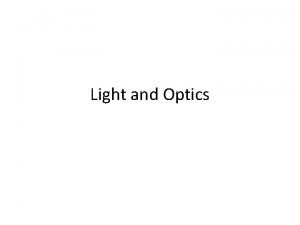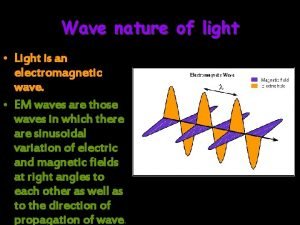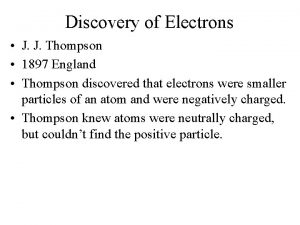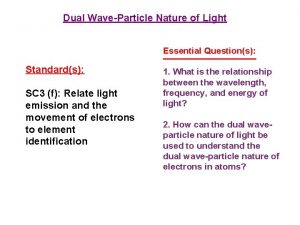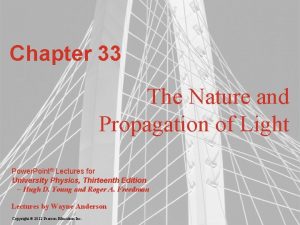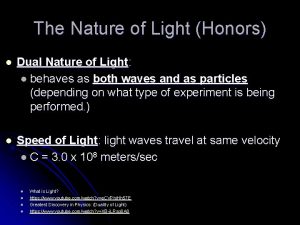NATURE OF LIGHT NATURE OF LIGHT Light is















- Slides: 15

NATURE OF LIGHT

NATURE OF LIGHT: • Light is a kind of energy that travels in waves. • Light travels very fast and straight in lines. • It can travel through a vacuum and many other media. • The speed of light in a vacuum is a universal constant in all reference frames.

• The speed of light in a vacuum is fixed at 299, 792, 458 m/s by the current definition of the meter. • The speed of light in a medium is always slower the speed of light in a vacuum. • The speed of light depends upon the medium through which it travels. The speed of anything with mass is always less than the speed of light in a vacuum.

REFLECTION & REFRACTION: REFLECTION REFRACTION • Reflection is described as the reverting back of light or sound waves in the same medium, when it falls on plane. • Refraction means the shift in direction of the radio waves, when it enters medium with different density.

REFLECTION REFRACTION • Light returns to the same medium. • Waves bounce of the plane and changes direction. • Angle of incidence is equal to angle of reflection. • Light travels from one medium to another. • Waves pass through the surface, that changes their speed and direction. • Angle of incidence is not equal to angle of refraction. • Occurs in mirrors. • Occurs in lenses.

TYPES AND USES OF LENSES: • Lenses are the pieces of transparent material of which one or both sides are spherical. • It is any transparent material having two surfaces, of which at least one is curved. • Lenses refract light in such a way that an image of the object is formed. • Each surface of a lens is a part of a sphere. • Common types of lenses, the convex lenses, concave lenses and, contact lenses.

TYPES OF LENSES: • Convex lenses • “The lens which causes incident parallel rays to diverge at a point is known as a convex or converging lens. This lens is thick at the centre but thin at the edges. ”

• Concave lenses • “Another type of lens causes the parallel rays of light to diverge from a point. This is called a concave or diverging lens. This lens is thin at the centre and thick at the edges. ”

DIFFERENCE BETWEEN CONCAVE AND CONVEX LENS: CONVEX LENS CONCAVE LENS • It forms real image • Its principal focus is real. • It is thick in middles. • It is thin from corners. • It forms virtual image • Its principal focus is virtual. • It is thick at corners. • It is thin from middle.

USES OF LENSES: • Microscopes • Cameras • Human eye • Magnifying glass • Flashlights • Slide projectors

IMAGE FORMATION IN A SIMPLE CAMERA: • Camera is a kind of box to which a convex lens is mounted on the front side. • The lens forms a real and inverted image of an object on the sensitive film placed behind it. • A system is provided in the camera to move the lens back and forth so that sharp image is obtained on the film. • There is shutter behind the lens that remains close normally. When the button is pressed, the shutter opens for a while.

• Light coming from the object enters the camera during this interval and images formed on the film. • The amount of light entering into the camera depends upon the size of aperture. • This can be made smaller or larger as required. The picture is obtained by developing the image on the film.

IMAGE FORMATION IN HUMAN EYE: • Light rays enter the eye through the cornea, the clear front “window” of the eye. The cornea’s refractive power bends the light rays in such a way that they pass freely through the pupil the opening in the centre of the iris through which light enters the eye. • The iris works like a shutter in a camera. It has the ability to enlarge and shrink, depending on how much light is entering the eye. • After passing through the iris, the light rays pass thru the eye’s natural crystalline lens. This clear, flexible structure works like the lens in a camera, shortening and lengthening its width in order to focus light rays properly.

• Light rays pass through a dense, transparent gel-like substance, called the vitreous that fills the globe of the eyeball and helps the eye hold its spherical shape. • In a normal eye, the light rays come to a sharp focusing point on the retina. The retina functions much like the film in a camera. It is responsible for capturing all of the light rays, processing them into light impulses through millions of tiny nerve endings, then sending these light impulses through over a million nerve fibber to the optic nerve. • Because the keratoconus cornea is irregular and cone shaped, light rays enter the eye at different angles, and do not focus on one point the retina, but on many different points causing a blurred, distorted image.

 Light light light chapter 22
Light light light chapter 22 Light light light chapter 22
Light light light chapter 22 Light light light chapter 23
Light light light chapter 23 Nature nature controversy
Nature nature controversy Nature and nature's laws lay hid in night meaning
Nature and nature's laws lay hid in night meaning Uses of concave and convex mirror
Uses of concave and convex mirror Dual nature of light
Dual nature of light Nature of light
Nature of light Thompson
Thompson Rmivuxg how to remember
Rmivuxg how to remember Dual nature of light
Dual nature of light Photon
Photon Nature and propagation of light
Nature and propagation of light What type of materials can block the path of a light
What type of materials can block the path of a light Put out the light othello
Put out the light othello Bouncing off of light
Bouncing off of light





